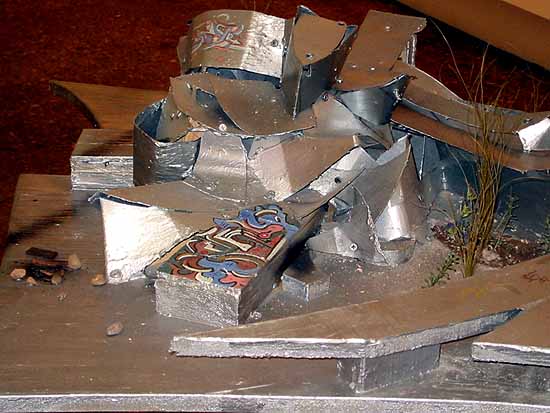"Paradise/Paradox," Castle Gallery, The College of New Rochelle, Curated by Susan M. Canning
by Tom Moody(Originally published in Sculpture, March 2004)
This sprawling, contentious exhibit, curated by Susan M. Canning, might best be described in terms of dueling aphorisms: “If you build it they will come” versus “Be careful what you wish for or you might get it.” The subject is utopia--on the drawing boards, as built, and in actual practice. The show’s two-dimensional work includes plans, diagrams, flow charts, and working sketches, often detailing fanciful, quasi-alchemical schemes. Freestanding sculptures and tabletop models feature designs that inspire as well as those doomed to ignominious failure. Photos, videos, and installation pieces document collective enterprises--from small communes to big cities--where lofty dreams become unruly “facts on the ground.”
Much of the painting and drawing has an air of world-building or cataloguing, an impulse shared by 16th Century mages, 19th Century taxonomists, and 21st Century obsessives. Matt Mullican presents a kind of visual dictionary of forms, including crystals, silhouettes of bones, great monuments, classic statuary, and a veritable Noah’s Ark of animal species. Jesse Bransford’s multi-layered drawing (B.O.C.) Stairway to the Stars, 2000, expands the lexicon with a star map, a Gothic façade, and pictures of medieval demons. A lovingly drawn profile of a Federation starship from the Star Trek TV series gives Bransford's pastiche an edge of the “otaku” (fanatic collector) sensibility, while renderings of the Heaven’s Gate keyhole logo and an extraterrestrial “gray” wearing an astrological pendant represent the just plain fanatic.
The three-dimensional work in the show is a curious mix of the hopeful, the cautionary, and the misguided. Recalling a 1950s model kit for high school biology students, Michael Joo’s Small Vitrine, 2000, presents a seated Buddha in clear cast plastic, with plastic bones and internal organs completely revealed. Conspicuously absent is the Holy One’s head, perhaps reflecting the ancient Zen wisdom that it’s the body part that gets us into the most trouble. And as if to prove Joo’s point, Colin Keefe shows us an overdetermined idea of Heaven, 2001, a seven-foot-tall model of a gyroscope-shaped space colony, which perpetuates, out among the stars, many of the foibles of 20th Century urban planning. On the inner surfaces of this partial Dyson sphere, living space in the form of hundreds of densely clustered high-rise buildings is segregated on two of the rings while the third is empty greenbelt. Another work of Keefe’s, a drawing on a nearby wall, shows a series of barricaded enclaves separating city-dwellers from what appears to be unoccupied land. Yet if it’s truly empty, why have the barricades? Finally, Jason Middlebrook mocks present-day notions of Heaven on earth with an entropic, post-apocalyptic re-envisioning of Frank Gehry’s Guggenheim Bilbao design. The artist gets revenge on a pretentious architect by imagining the building partially collapsed, surrounded by weeds and rubble, and festooned with graffiti.
A recurring theme of the show is how the totalizing impulse shades over into the totalitarian. In Justine Kurland’s photo of the residents of Zendik Farm, an actual commune in upstate New York, several dozen happy, centered-looking people pose for a group portrait, but in Lenore Malen’s installation The New Society for Universal Harmony, 2002, which elaborately documents a fictional therapy center (also upstate), visitors are hooked to weird electrical meters and elaborately profiled, uncomfortably reminding us of a religion founded by a certain best-selling science fiction writer who shall remain nameless. Fred Tomaselli’s Utopia Mountains, 1998, a kind of psychedelic topographical map, imagines a host of famous communes all located within a few miles of each other. Tellingly, the list includes, in addition to Shakers, Perfectionists, and Harmonists, less noble enterprises such as the Manson Family and that famous colony of one, the “Kaczynski Cabin.”Above: Jason Middlebrook, Guggenheim Bilbao, Part II (2002, wood, paint, polystyrene, 34.25 x 52 x 39 in.).
